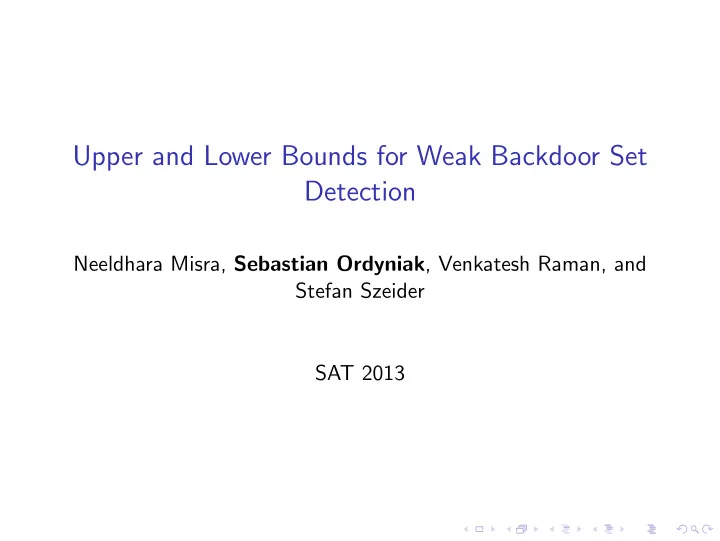

Upper and Lower Bounds for Weak Backdoor Set Detection Neeldhara Misra, Sebastian Ordyniak , Venkatesh Raman, and Stefan Szeider SAT 2013
Backdoor Sets ◮ Introduced by Crama et al. 1997 and independently by Williams et al. 2003 in an attempt to explain the good performance of SAT-solvers. ◮ Have been intensively studied as a structural parameter in various fields of AI (Gaspers and Szeider 2012). d ◮ Provide a measure for the distance of a CNF-formula to some tractable base class.
Weak Backdoor Sets Definition Let C be a tractable class of CNF formulas, F a CNF formula, and B a set of variables of F . Then B is a weak C -backdoor set of F if there is an assignment τ for the variables of B such that: F [ τ ] is satisfiable and F [ τ ] ∈ C . Observation Given a formula F and a weak C -backdoor set B for some tractable class C , then a satisfying assignment of F can be found in time O (2 | B | p ( | F | )). Hence, the main task is to efficiently find a small weak backdoor set!
Islands of Tractability 0 -Val We consider the following “islands Forest Match of tractability”: ◮ Krom ◮ Horn and Horn co-Horn ◮ 0 -Val and Krom 1 -Val ◮ Forest ◮ Match
Complexity of Finding Weak Backdoor Sets ◮ Unfortunately, for all of these base classes , finding weak backdoor sets cannot be done efficiently, i.e., it is fixed-parameter intractable! ◮ However, if we restrict the length of the clauses of the input formula to a constant, then finding weak backdoor sets is fixed-parameter tractable (for all but Match ). Here we focus on exact upper bounds and lower bounds for the complexity of finding a weak backdoor set when the input formula has at most 3 literals per clause ( 3CNF ).
Finding Weak Backdoor Sets We consider the following problem (here C is a tractable class of CNF formulas): Weak ( 3CNF , C ) -Backdoor Detection Parameter: k Input: A formula 3CNF formula F and a natural number k . Question: Does F have a weak C -backdoor set of size at most k ?
Our Results ◮ We improve the current upper bounds for weak backdoor detection for the classes Krom and Horn from 6 k to 2 . 27 k and 4 . 54 k , respectively. ◮ We show the first lower bounds for weak backdoor detection for the classes Krom , Horn , 0 -Val , Forest , and Match .
Our Results – in detail Upper bounds and lower bounds for Weak ( 3CNF , B ) -Backdoor Detection : B Lower bound Upper bound 2 k 2 . 27 k Krom 2 k 4 . 54 k Horn 2 . 85 k (1) 2 o ( k ) 0 -Val 2 k f ( k ) (2) Forest k 2 − ǫ n k Match n (1) Raman and Shankar 2013 (2) Gaspers and Szeider 2012 (3) Gaspers, Ordyniak, Ramanujan, Saurabh, and Szeider 2013
Methods Lower bounds We show the lower bounds by a reduction from SAT using the (Strong) Exponential Time Hypothesis. Upper bounds ◮ The algorithm for Krom uses a reduction to 3 -Hitting Set . ◮ For Horn we use a sophisticated branching algorithm applying ideas from Raman and Shankar 2013.
Conclusion We initiated a systematic study of the complexity of finding weak backdoor sets of 3CNF formulas. This lead to: ◮ improved algorithms for several base classes, and ◮ the first lower bounds for many base classes.
Future Work ◮ Close the gaps between upper and lower bounds of the considered problems. ◮ Study Weak ( A , B ) -backdoor Set for other restrictions of the input formulas ( A ) than 3CNF .
Thank You!
Recommend
More recommend